Milk Snake
Lampropeltis triangulum
Advertisement
Milk Snake Scientific Classification
- Kingdom
- Animalia
- Phylum
- Chordata
- Class
- Reptilia
- Order
- Squamata
- Family
- Colubridae
- Genus
- Lampropeltis
- Scientific Name
- Lampropeltis triangulum
Read our Complete Guide to Classification of Animals.
Milk Snake Conservation Status
Milk Snake Facts
View all of the Milk Snake images!
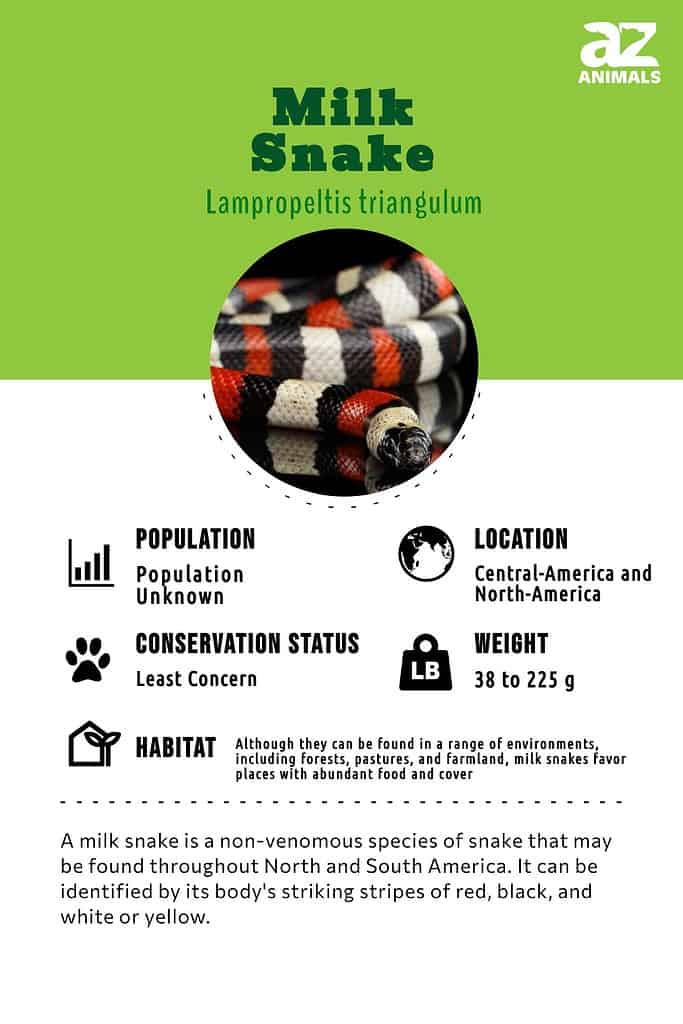
The milk snake is an elusive and interesting reptile, mimicking the appearance of much more dangerous snakes to deter predators.
This snake has up to a 22-year lifespan when kept in captivity, which is nearly six times the amount of time they survive in the wild. With 24 different species, there are no conservation efforts needed to keep these nonvenomous species alive.
5 Incredible Milk Snake Facts!

These snakes come in a wide range of sizes, with some species reaching lengths of 69 inches while others only reach 14 inches. Milk snakes in Central and South America are the largest.
©Seregraff/Shutterstock.com
- The size of these snakes ranges greatly among the many species, growing as short as 14 inches and as long as 69 inches. Central and South America have milk snakes with the largest size.
- Every milk snake has 19-23 rows of scales.
- Their greatest defense mechanism is mimicry, as they look fairly similar to several species of snakes that are much more dangerous than them.
- The prey of these snakes is quite broad, as they’ll eat mammals, birds, and even other reptiles. In fact, they are bold enough to go after coral snakes as their meal, which is one of the snakes they mimic in appearance.
- In the wild, the average lifespan of a milk snake is three to four years. In captivity, there are some records of snakes living to be 22 years old.
Evolution and Origins
The eastern milksnake is a prevalent snake variety discovered in Connecticut, and it was often spotted in barns that were infested with rodents, which gave rise to the false notion that they sucked milk from cows at night.
Interestingly enough, milk snakes, contrary to their name, do not consume milk. This misconception was given by farmers who mistakenly thought that these snakes would crawl beneath a cow’s udder to drink milk.
While scientists have confirmed that milk snakes do not possess the appropriate mouth structure to extract milk from udders, the name has persisted.
Different Types
Here are the different types of milk snakes:
- Eastern milk snake (Lampropeltis triangulum)
- New Mexico milk snake (Lampropeltis triangulum celaenops)
- Central Plains milk snake (Lampropeltis triangulum gentilis)
- Western milk snake (Lampropeltis triangulum hondurensis)
- Black milk snake (Lampropeltis triangulum gaigeae)
- Red milk snake (Lampropeltis triangulum syspila)
- Sinaloan milk snake (Lampropeltis triangulum sinaloae)
- Mexican milk snake (Lampropeltis triangulum annulata)
- Pueblan milk snake (Lampropeltis triangulum campbelli)
Where to Find Milk Snakes
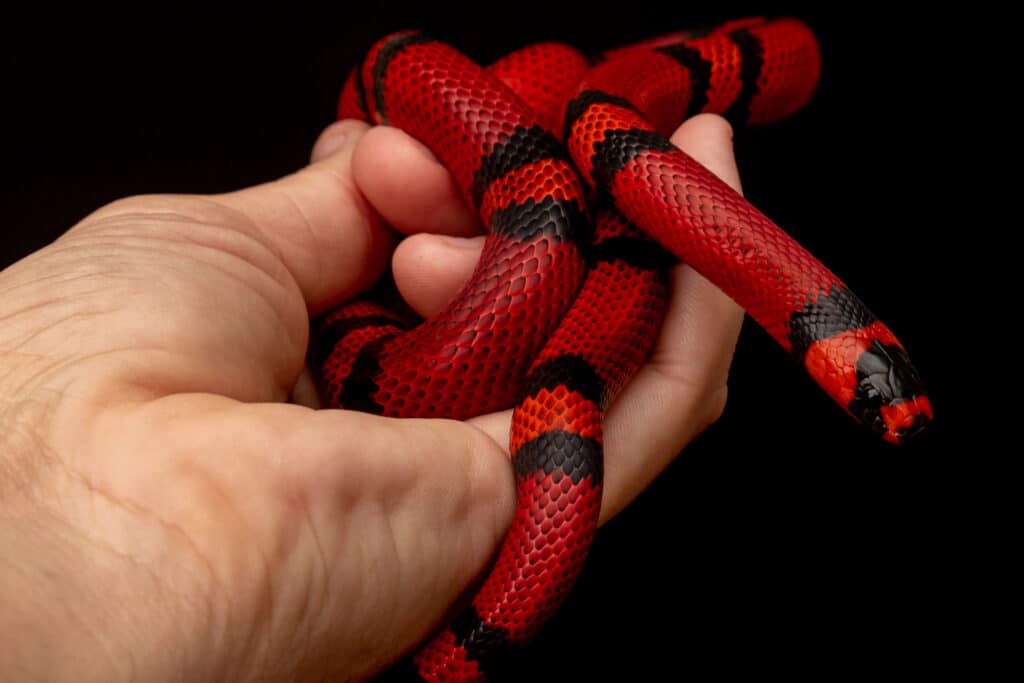
Although milk snakes come in a huge variety of kinds, they can only be found in a few places on earth.
©Murilo Mazzo/Shutterstock.com
Though there are so many different species of milk snake, they are only found in a specific locations of the world. In North America, the main location for these snakes is in the continental United States and Central America. They can be found as far south as the northern region of South America. They are also found as high north as southeastern Canada. Considering this small range, it is unlikely you’ll see milk snakes beyond the western hemisphere.
The milk snake tends to be fairly adaptable to different habitats and locations. Often found in the forest, some snakes will journey to open prairies to meet their dietary needs. They can also make a home on rocky slopes, migrating to drier areas to hibernate. When the summertime comes, these snakes seek out moist environments.
Scientific Name
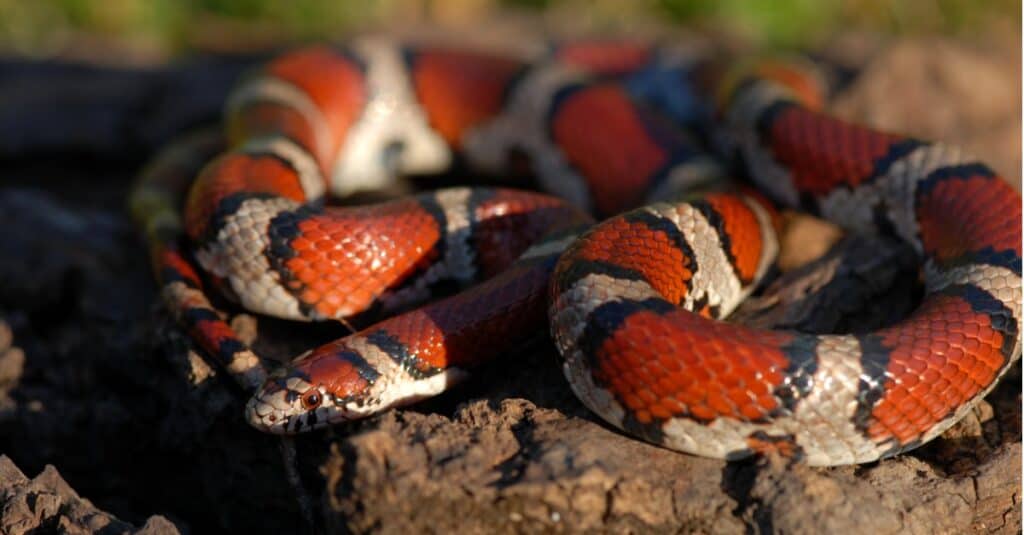
©iStock.com/Shoemcfly
This snake’s scientific name is Lampropeltis Triangulum, which is Greek and Latin. Lampropeltis translates to “radiant small shields,” while Triangulum means “having three angles.” While it doesn’t go by any other name, there are several species that come from this group, including the eastern milk snake and the black milk snake. In total, there are approximately 24 subspecies.
The Different Types of Milk Snakes
In total, there are 24 recognized species of milk snakes in the Western Hemisphere. Identification of milk snakes is rather difficult because they look so much like some dangerous species. However, each one is non-venomous.
Here are a few of the different species you may find, as well as the proper identification criteria for each.
- Eastern milk snake: The Eastern milk snake is one of the most popular varieties known today. It is primarily found in the northeast region of the United States, growing to be about four feet long. Identification of this snake is easy because of its alternating black and white colors.
- Black milk snake: The black milk snake has alternating bands of red, black, and white/yellow when they are first born. However, they will start to turn solid black as they near their adult years. As predators, they need to be fed properly in captivity to avoid becoming obese.
- Pueblan milk snake: This species of snake is often confused with other intimidating predators — the coral snake. Their red bands are double the width of the white and black bands, and they only grow to be about 2.5 feet long.
Population and Conservation Status
There are many variations of this snake found around the world, but the total population is unknown. Still, the population is stable, and some species of milk snakes are bred for pet stores nowadays. The conservation status of the milk snake is “least concern.”
Appearance and Description

©iStock.com/David Kenny
Even though there are a few types of milk snakes, every variation has a striped or blotchy pattern along its scales. Typically, the stripes are white or a light color, while the area between them is dark. The color varies among the species. The lighter colors tend to be white, yellow, or orange. The dark colors, on the other hand, can be dark brown to a light tan. Every dark section has a black stripe to separate it from the lighter stripe.
Generally, its size ranges from 24 to 52 inches, depending on the particular species. Some ways to identify these species are as follows:
- Alternating dark and light sections.
- Dark sections are outlined in black.
- No smaller than 24 inches.
Milk Snakes vs. Coral and Other Snakes
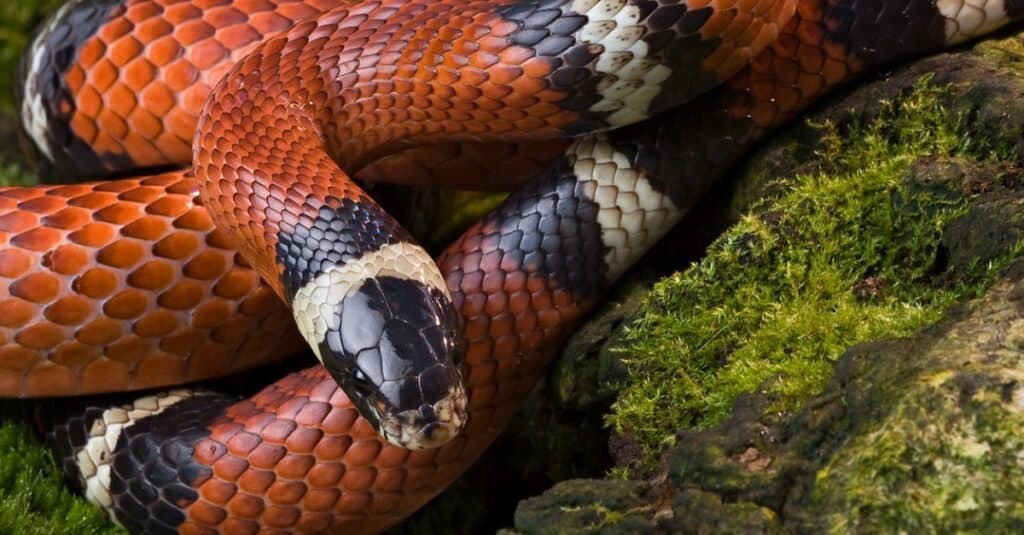
©iStock.com/wScottLoy
Milk snakes are often mistaken for venomous snakes like coral snake. When comparing milk snakes and coral snakes remember the simple rhyme, “Red on yellow kills a fellow, red on black a friend of Jack.” This rhyme describes how coral snakes will have red that touches yellow bands while milk snakes have red that touches black bands.
Milk snakes are often confused with other venomous snakes including copperheads. In this case, just remember that copperheads have markings that look like an hourglass and a coloration that’s browner.
Venom: How Dangerous Are They?
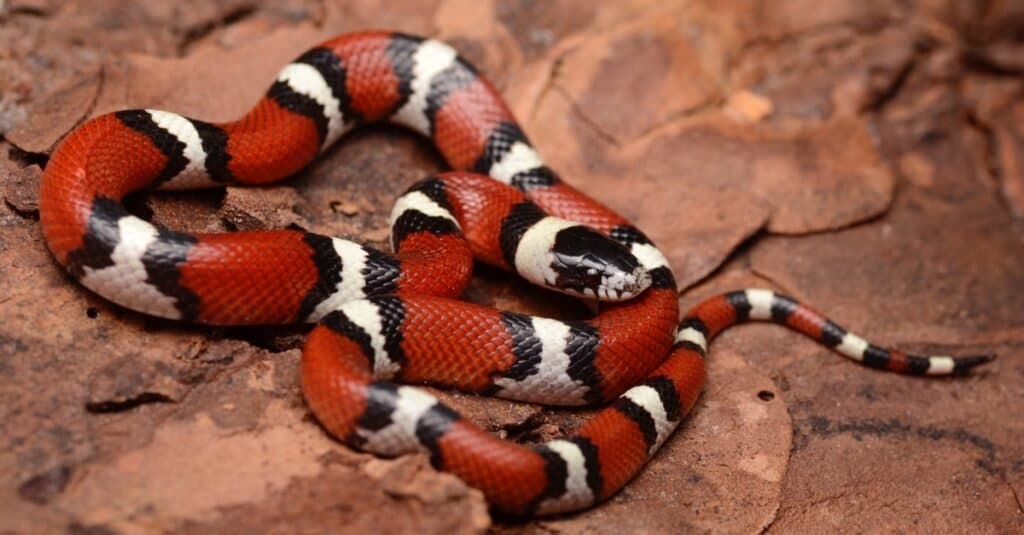
Louisiana Milk-snake found after a fall cold front blew through southeast Texas. The common name “milk snake” originated from the false belief that these snakes milked cows.
©TheTexasNaturalist/Shutterstock.com
This snake may look as bold and beautiful as the many venomous snakes in the world today, but their colors are not a sign of danger. Milk snakes are nonvenomous, and the only cause of any aggression is if they feel as though they are in danger. At that time, they will attempt to strike predators or humans threatening them. They’ll even mimic the shaking tail that a copperhead snake or a rattlesnake does.
If the milk snake bites you, you should wash and clean the broken skin immediately. Even though there is no risk of poison from venom (since there is none), their mouths contain bacteria that could make you sick. Even if you do not become sick, this bacteria can lead to infection.
The diet of this snake doesn’t often involve humans, but mammals are on the menu. Their typical diet involves many types of prey, though they tend to go after rodents, lizards, other snakes, and mammals. They’ll also eat the eggs of other snakes and birds. They may not use their bite as their main defense, but they constrict their prey until it is dead before swallowing it whole.
Behavior and Humans
For the most part, this snake is rather peaceful. They aren’t dangerous at all because they aren’t venomous. However, that’s not to say that they are completely docile. Instead, this snake becomes rather aggressive when it feels threatened. Despite this reaction, milk snakes are often kept as pets by humans in North America.
View all 164 animals that start with MMilk Snake FAQs (Frequently Asked Questions)
Milk Snakes vs. Copperheads
While milk snakes are most often compared to coral snakes, they can also
Are milk snakes harmful?
Milk snakes are not venomous to humans, but are often mistaken for deadly Coral snakes, Agkistrodon and Sistrurus Genus, and Pygmy rattlers. This association is often due to the many patterns and alternating color bands as a result of Batesian mimicry.
Why is it called milk snake?
The name “milk snake” comes from a namesake folktale that they lived in barns to feed on the milk of the cows. In reality, they lived in barns for the rodent food source.
Are milk snakes friendly?
Milk snakes are likely to be hidden and secretive when left alone and are not known to be adventurous and friendly. Despite being commonly bred to be a pet, they need their space. Otherwise, they may bite to warn you.
Are milk snakes aggressive?
When a Milk snake is trapped with no option for escape, they become highly energetic, attempting to bite you while vibrating their tail. These defense mechanisms are meant to mimic a venomous snake such as a copperhead, rattlers, or other pit vipers, making you think you are in grave danger. However, they don’t even have venom.
Where are milk snakes found?
Living mainly in forest regions, the preferred habitat of the milk snake is typically on rocky slopes or open prairies. These habitats can be found across North America and some of South America. Due to the darkened space, they often can be found in barns.
Do milk snakes drink milk from cows?
Milk snakes do not drink milk from cows, though the idea that they might is why they are called “milk snakes.” Instead, they most often go after rodents as their prey, which are often found in barns where milk cows reside.
What other snakes are red?
There are a variety of red snakes beyond the milk snake. Some species include the scarlet snake, coral snake, mud snake, redback coffee snake, and even the Sumatran blood python.
Are milk snakes venomous?
This reptile is non-venomous.
How do milk snakes hunt?
As a nocturnal species, milk snakes hunt their prey at night.
Where do milk snakes live?
Milk snakes live in cold, damp, and dark hiding spots such as barns, boards, forest floors, and rocky slopes found across North America.
What do milk snakes eat?
Being carnivorous snakes, the adults prey on rodents, reptiles (like other snakes), invertebrates, birds, and their eggs. Young milk snakes prey on small lizards, slugs, earthworms, crickets, and other insects.
How big was the largest milk snake?
The largest milk snake ever recorded was a black milk snake that measured 7 feet long!
What are the differences between copperheads and eastern milk snakes?
The major differences between the copperhead and eastern milk snake lie in their families, modes of attack and defense, their temperaments, and of course, their looks.
Thank you for reading! Have some feedback for us? Contact the AZ Animals editorial team.
Sources
- LiveScience, Available here: https://www.livescience.com/53333-milk-snakes.html
- REPTILEHOW.com, Available here: https://reptilehow.com/do-milk-snakes-bite/
- Kids' Inquiry of Diverse Species, Available here: http://www.biokids.umich.edu/critters/Lampropeltis_triangulum/
- Virginia Herpetological Society, Available here: https://www.virginiaherpetologicalsociety.com/reptiles/snakes/eastern-milk-snake/eastern_milksnake.php

















